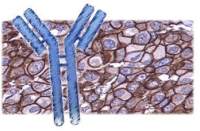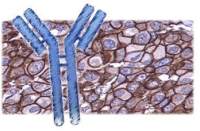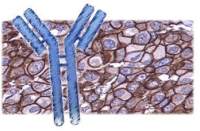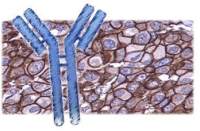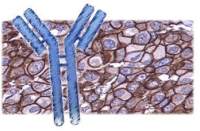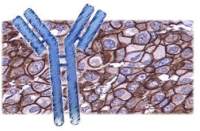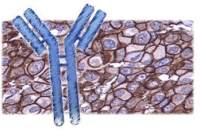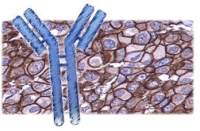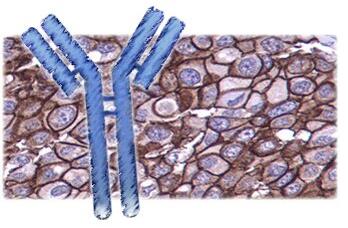
产品详情
文献和实验
相关推荐
供应商 :上海联迈生物工程有限公司
库存 :大量
靶点 :详见说明书
级别 :1
目录编号 :LM-1392R-FITC
克隆性 :多克隆
抗原来源 :Rabbit
保质期 :1年
抗体英文名 :Anti-CDC34/FITC
抗体名 :Anti-CDC34/FITC
标记物 :FITC标记
宿主 :Human, Mouse, Rat, Chicken, Dog, Pig, Cow, Guinea Pig,
适应物种 :Human, Mouse, Rat, Chicken, Dog, Pig, Cow, Guinea Pig,
免疫原 :详见说明书
亚型 :IGg
形态 :粉末、液体、冻干粉
应用范围 :IF=1:50-200
浓度 :1mg/ml
保存条件 :-20 °C
规格 :100ul
FITC标记的细胞周期调控因子34| 英文名称 | Anti-CDC34/FITC |
| 中文名称 | FITC标记的细胞周期调控因子34 |
| 别 名 | Cdc 34; Cdc34; Cell division cycle 34; Cell division cycle 34 homolog (S. cerevisiae); Cell division cycle 34 homolog; E2 CDC34; UB2R1_HUMAN; UBC 3; UBC3; UBCH3; UBE2 R1; UBE2R1; Ubiquitin carrier protein; Ubiquitin conjugating enzyme Cdc34; Ubiquitin conjugating enzyme E2 32 kDa complementing; Ubiquitin protein ligase; Ubiquitin protein ligase R1; Ubiquitin-conjugating enzyme E2 R1; Ubiquitin-conjugating enzyme E2-32 kDa complementing; Ubiquitin-conjugating enzyme E2-CDC34; Ubiquitin-protein ligase R1 |
| 规格价格 | 100ul/2980元 购买 大包装/询价 |
| 说 明 书 | 100ul |
| 研究领域 | 细胞生物 细胞凋亡 细胞周期蛋白 转录调节因子 |
| 抗体来源 | Rabbit |
| 克隆类型 | Polyclonal |
| 交叉反应 | Human, Mouse, Rat, Chicken, Dog, Pig, Cow, Guinea Pig, |
| 产品应用 | IF=1:50-200 not yet tested in other applications. optimal dilutions/concentrations should be determined by the end user. |
| 分 子 量 | 26kDa |
| 性 状 | Lyophilized or Liquid |
| 浓 度 | 1mg/ml |
| 免 疫 原 | KLH conjugated synthetic peptide derived from human Cdc34 |
| 亚 型 | IgG |
| 纯化方法 | affinity purified by Protein A |
| 储 存 液 | 0.01M TBS(pH7.4) with 1% BSA, 0.03% Proclin300 and 50% Glycerol. |
| 保存条件 | Store at -20 °C for one year. Avoid repeated freeze/thaw cycles. The lyophilized antibody is stable at room temperature for at least one month and for greater than a year when kept at -20°C. When reconstituted in sterile pH 7.4 0.01M PBS or diluent of antibody the antibody is stable for at least two weeks at 2-4 °C. |
| 产品介绍 | background: Accepts ubiquitin from the E1 complex and catalyzes its covalent attachment to other proteins. In vitro catalyzes 'Lys-48'-linked polyubiquitination. Cooperates with the E2 UBCH5C and the SCF(FBXW11) E3 ligase complex for the polyubiquitination of NFKBIA leading to its subsequent proteasomal degradation. Performs ubiquitin chain elongation building ubiquitin chains from the UBE2D3-primed NFKBIA-linked ubiquitin. UBE2D3 acts as an initiator E2, priming the phosphorylated NFKBIA target at positions 'Lys-21' and/or 'Lys-22' with a monoubiquitin. Cooperates with the SCF(SKP2) E3 ligase complex to regulate cell proliferation through ubiquitination and degradation of MYBL2 and KIP1. Involved in ubiquitin conjugation and degradation of CREM isoform ICERIIgamma and ATF15 resulting in abrogation of ICERIIgamma- and ATF5-mediated repression of cAMP-induced transcription during both meiotic and mitotic cell cycles. Involved in the regulation of the cell cycle G2/M phase through its targeting of the WEE1 kinase for ubiquitination and degradation. Also involved in the degradation of beta-catenin. Is target of human herpes virus 1 protein ICP0, leading to ICP0-dependent dynamic interaction with proteasomes. Function: Accepts ubiquitin from the E1 complex and catalyzes its covalent attachment to other proteins. In vitro catalyzes 'Lys-48'-linked polyubiquitination. Cooperates with the E2 UBCH5C and the SCF(FBXW11) E3 ligase complex for the polyubiquitination of NFKBIA leading to its subsequent proteasomal degradation. Performs ubiquitin chain elongation building ubiquitin chains from the UBE2D3-primed NFKBIA-linked ubiquitin. UBE2D3 acts as an initiator E2, priming the phosphorylated NFKBIA target at positions 'Lys-21' and/or 'Lys-22' with a monoubiquitin. Cooperates with the SCF(SKP2) E3 ligase complex to regulate cell proliferation through ubiquitination and degradation of MYBL2 and KIP1. Involved in ubiquitin conjugation and degradation of CREM isoform ICERIIgamma and ATF15 resulting in abrogation of ICERIIgamma- and ATF5-mediated repression of cAMP-induced transcription during both meiotic and mitotic cell cycles. Involved in the regulation of the cell cycle G2/M phase throught its targeting of the WEE1 kinase for ubiquitination and degradation. Also involved in the degradation of beta-catenin. Is target of human herpes virus 1 protein ICP0, leading to ICP0-dependent dynamic interaction with proteasomes. Subunit: Interacts with SCF (SKP1-CUL1-F-box protein) E3 ubiquitin ligase complex. When cullin is neddylated, the interaction between the E2 and the SCF complex is strengthened. When phosphorylated, interacts with beta-TrCP (BTRC). Interacts with human herpes virus protein ICP0 and associates with the proteasome for degradation. Interacts with casein kinase subunit CSNK2B. Subcellular Location: Cytoplasm. Nucleus. Note=The phosphorylation of the C-terminal tail plays an important role in mediating nuclear localization. Colocalizes with beta-tubulin on mitotic spindles in anaphase. Tissue Specificity: Expressed in testes during spermatogenesis to regulate repression of cAMP-induced transcription. Post-translational modifications: Autoubiquitinated. Autoubiquitination is promoted by the human herpes virus 1 protein ICP0 and leads to degradation by the Ubiquitin-proteasomal pathway. Phosphorylated by CK2. Phosphorylation of the C-terminal tail by CK2 controles the nuclear localization. Similarity: Belongs to the ubiquitin-conjugating enzyme family. Database links: Entrez Gene: 997 Human Entrez Gene: 216150 Mouse Entrez Gene: 299602 Rat Omim: 116948 Human SwissProt: P49427 Human SwissProt: Q8CFI2 Mouse Unigene: 514997 Human Unigene: 21981 Mouse Unigene: 2427 Rat Important Note: This product as supplied is intended for research use only, not for use in human, therapeutic or diagnostic applications. 经研究证实细胞周期调控因子Cdc34是泛素转运酶E2中的成员之一,参与G1期周期素的降解,在进化上高度保守。 |

上海联迈生物工程有限公司
品牌商实名认证
钻石会员
入驻年限:8年

